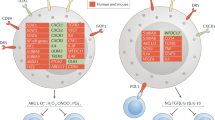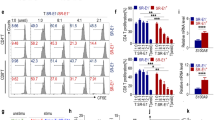Abstract
Myeloid-derived suppressor cells (MDSCs) are pathologically activated and relatively immature myeloid cells that have been implicated in the immunological regulation of many pathologic conditions1,2. Phenotypically and morphologically, MDSCs are similar to neutrophils (PMN-MDSCs) and monocytes (M-MDSCs). However, they have potent suppressive activity and distinct gene expression profiles and biochemical characteristics3. No or very few MDSCs are observed in steady-state physiological conditions. Therefore, until recently, accumulation of MDSCs was considered a consequence of pathological processes or pregnancy. Here, we report that MDSCs with a potent ability to suppress T cells are present during the first weeks of life in mice and humans. MDSC suppressive activity was triggered by lactoferrin and mediated by nitric oxide, PGE2, and S100A9 and S100A8 proteins. MDSCs from newborns had a transcriptome similar to that of tumor MDSCs, but with strong upregulation of an antimicrobial gene network, and had potent antibacterial activity. MDSCs played a critical role in control of experimental necrotizing enterocolitis (NEC) in newborn mice. MDSCs in infants with very low weight, who are prone to NEC, had lower MDSC levels and suppressive activity than did infants with normal weight. Thus, the transitory presence of MDSCs may be critical for regulation of inflammation in newborns.
This is a preview of subscription content, access via your institution
Access options
Access Nature and 54 other Nature Portfolio journals
Get Nature+, our best-value online-access subscription
$29.99 / 30 days
cancel any time
Subscribe to this journal
Receive 12 print issues and online access
$209.00 per year
only $17.42 per issue
Buy this article
- Purchase on SpringerLink
- Instant access to full article PDF
Prices may be subject to local taxes which are calculated during checkout




Similar content being viewed by others
Accession codes
References
Marvel, D. & Gabrilovich, D.I. Myeloid-derived suppressor cells in the tumor microenvironment: expect the unexpected. J. Clin. Invest. 125, 3356–3364 (2015).
Gabrilovich, D.I. Myeloid-derived suppressor cells. Cancer Immunol. Res. 5, 3–8 (2017).
Bronte, V. et al. Recommendations for myeloid-derived suppressor cell nomenclature and characterization standards. Nat. Commun. 7, 12150 (2016).
Veglia, F., Perego, M. & Gabrilovich, D. Myeloid-derived suppressor cells coming of age. Nat. Immunol. https://doi.org/10.1038/s41590-017-0022-x 2018).
Obermajer, N. et al. PGE2-driven induction and maintenance of cancer-associated myeloid-derived suppressor cells. Immunol. Invest. 41, 635–657 (2012).
Nagaraj, S. et al. Antigen-specific CD4+ T cells regulate function of myeloid-derived suppressor cells in cancer via retrograde MHC class II signaling. Cancer Res. 72, 928–938 (2012).
Youn, J.I., Collazo, M., Shalova, I.N., Biswas, S.K. & Gabrilovich, D.I. Characterization of the nature of granulocytic myeloid-derived suppressor cells in tumor-bearing mice. J. Leukoc. Biol. 91, 167–181 (2012).
Manitz, M.P. et al. Loss of S100A9 (MRP14) results in reduced interleukin-8-induced CD11b surface expression, a polarized microfilament system, and diminished responsiveness to chemoattractants in vitro. Mol. Cell. Biol. 23, 1034–1043 (2003).
Park, J.Y., Pillinger, M.H. & Abramson, S.B. Prostaglandin E2 synthesis and secretion: the role of PGE2 synthases. Clin. Immunol. 119, 229–240 (2006).
Deshmukh, H.S. et al. The microbiota regulates neutrophil homeostasis and host resistance to Escherichia coli K1 sepsis in neonatal mice. Nat. Med. 20, 524–530 (2014).
Vogel, H.J. Lactoferrin, a bird's eye view. Biochem. Cell Biol. 90, 233–244 (2012).
Warner, B.B. & Tarr, P.I. Necrotizing enterocolitis and preterm infant gut bacteria. Semin. Fetal Neonatal Med. 21, 394–399 (2016).
Denning, T.L., Bhatia, A.M., Kane, A.F., Patel, R.M. & Denning, P.L. Pathogenesis of NEC: role of the innate and adaptive immune response. Semin. Perinatol. 41, 15–28 (2017).
Condamine, T. et al. Lectin-type oxidized LDL receptor-1 distinguishes population of human polymorphonuclear myeloid-derived suppressor cells in cancer patients. Sci. Immunol. 1, aaf8943 (2016).
Niño, D.F., Sodhi, C.P. & Hackam, D.J. Necrotizing enterocolitis: new insights into pathogenesis and mechanisms. Nat. Rev. Gastroenterol. Hepatol. 13, 590–600 (2016).
Condamine, T. et al. ER stress regulates myeloid-derived suppressor cell fate through TRAIL-R-mediated apoptosis. J. Clin. Invest. 124, 2626–2639 (2014).
James, B.R. et al. CpG-mediated modulation of MDSC contributes to the efficacy of Ad5-TRAIL therapy against renal cell carcinoma. Cancer Immunol. Immunother. 63, 1213–1227 (2014).
Dominguez, G.A. et al. Selective targeting of myeloid-derived suppressor cells in cancer patients using DS-8273a, an agonistic TRAIL-R2 antibody. Clin. Cancer Res. 23, 2942–2950 (2017).
Egan, C.E. et al. Toll-like receptor 4-mediated lymphocyte influx induces neonatal necrotizing enterocolitis. J. Clin. Invest. 126, 495–508 (2016).
Gervassi, A. et al. Myeloid derived suppressor cells are present at high frequency in neonates and suppress in vitro T cell responses. PLoS One 9, e107816 (2014).
Curran, C.S. & Bertics, P.J. Lactoferrin regulates an axis involving CD11b and CD49d integrins and the chemokines MIP-1alpha and MCP-1 in GM-CSF-treated human primary eosinophils. J. Interferon Cytokine Res. 32, 450–461 (2012).
Cheng, P. et al. Inhibition of dendritic cell differentiation and accumulation of myeloid-derived suppressor cells in cancer is regulated by S100A9 protein. J. Exp. Med. 205, 2235–2249 (2008).
Heinemann, A.S. et al. In neonates S100A8/S100A9 alarmins prevent the expansion of a specific inflammatory monocyte population promoting septic shock. FASEB J. 31, 1153–1164 (2017).
Sinha, P. et al. Proinflammatory S100 proteins regulate the accumulation of myeloid-derived suppressor cells. J. Immunol. 181, 4666–4675 (2008).
St-Onge, M. et al. Characterization of prostaglandin E2 generation through the cyclooxygenase (COX)-2 pathway in human neutrophils. Biochim. Biophys. Acta 1771, 1235–1245 (2007).
Wehbi, V.L. & Taskén, K. Molecular mechanisms for cAMP-mediated immunoregulation in t cells: role of anchored protein kinase A signaling units. Front. Immunol. 7, 222 (2016).
Talukder, J.R., Griffin, A., Jaima, A., Boyd, B. & Wright, J. Lactoferrin ameliorates prostaglandin E2-mediated inhibition of Na+-glucose cotransport in enterocytes. Can. J. Physiol. Pharmacol. 92, 9–20 (2014).
Trentini, A. et al. Vaginal lactoferrin modulates PGE2, MMP-9, MMP-2, and TIMP-1 amniotic fluid concentrations. Mediators Inflamm. 2016, 3648719 (2016).
Rasheed, N., Alghasham, A. & Rasheed, Z. Lactoferrin from Camelus dromedarius inhibits nuclear transcription factor-kappa B activation, cyclooxygenase-2 expression and prostaglandin E2 production in stimulated human chondrocytes. Pharmacognosy Res. 8, 135–141 (2016).
Li, B. & Dewey, C.N. RSEM: accurate transcript quantification from RNA-Seq data with or without a reference genome. BMC Bioinformatics 12, 323 (2011).
Love, M.I., Huber, W. & Anders, S. Moderated estimation of fold change and dispersion for RNA-seq data with DESeq2. Genome Biol. 15, 550 (2014).
Mosconi, E. et al. Breast milk immune complexes are potent inducers of oral tolerance in neonates and prevent asthma development. Mucosal Immunol. 3, 461–474 (2010).
Tian, R. et al. Characterization of a necrotizing enterocolitis model in newborn mice. Int. J. Clin. Exp. Med. 3, 293–302 (2010).
Rager, T.M., Olson, J.K., Zhou, Y., Wang, Y. & Besner, G.E. Exosomes secreted from bone marrow-derived mesenchymal stem cells protect the intestines from experimental necrotizing enterocolitis. J. Pediatr. Surg. 51, 942–947 (2016).
Kubinak J.L. et al.MyD88 signaling in T cells directs IgA-mediated control of the microbiota to promote health. Cell Host Microbe 17, 153–163 (2015).
Acknowledgements
This work was supported by the Wistar Institute Animal and Bioinformatics core facilities as well as NIH grant CA165065 to D.I.G. and V.K. The work was also supported by the Recruitment Program for Foreign Experts (Thousand Talents Plan, WQ2014440O204), the Start-up Fund for High-level Talents of Sun Yat-sen University, and the Leading Talents of Guangdong Province Program (D.I.G.). This work was supported by the following grants to J.Z.: the Introduction of Innovative R&D Team Program of Guangdong Province (2009010058), the Guangdong Province Universities and Colleges Pearl River Scholar Funded Scheme (GDUPS, 2014), the National Natural Science Foundation of China (91542112; 81571520, 81771665, and 81742002), and the Provincial Talents Cultivated by the 'Thousand-Hundred-Ten' Program of Guangdong Province, 111 Project (B12003). We thank S. Grey-Owen (University of Toronto) and O.M. Conneely (Baylor College of Medicine) for providing LF-KO mice and T. Vogl and J. Roth (Institute of Immunology, Muenster) for providing S100A9-KO mice. We thank Y. Yu (Tianjin Medical University) for providing Cox-2-KO mice and H. Zhang (Sun Yat-sen University) for providing OT-1 transgenic mice.
Author information
Authors and Affiliations
Contributions
Conceptualization, D.I.G. and J.Z.; formal analysis, A.V.K.; investigation, Y.-M.H., X.L., M.P., Y.-F.L., S.-Y.F., Q.-J.Y., Y.-H.Z., and L.W.; resources, Y.N. and E.A.J.; writing original draft, D.I.G. and J.Z.; manuscript review and editing, D.I.G., J.Z., Y.N., and V.K.; supervision, D.I.G. and J.Z.; funding acquisition, D.I.G., J.Z., and V.K.
Corresponding authors
Ethics declarations
Competing interests
The authors declare no competing financial interests.
Supplementary information
Supplementary Text and Figures
Supplementary Figures 1–13 and Supplementary Tables 1–3 (PDF 3305 kb)
Rights and permissions
About this article
Cite this article
He, YM., Li, X., Perego, M. et al. Transitory presence of myeloid-derived suppressor cells in neonates is critical for control of inflammation. Nat Med 24, 224–231 (2018). https://doi.org/10.1038/nm.4467
Received:
Accepted:
Published:
Issue Date:
DOI: https://doi.org/10.1038/nm.4467
This article is cited by
-
Maternal circadian rhythm disruption affects neonatal inflammation via metabolic reprograming of myeloid cells
Nature Metabolism (2024)
-
Maternal rhythms suppress neonatal inflammation
Nature Metabolism (2024)
-
Neuropilin-1high monocytes protect against neonatal inflammation
Cellular & Molecular Immunology (2024)
-
Comprehensive mapping of immune perturbations associated with aplastic anemia
Cell Biology and Toxicology (2024)
-
Dynamic intrauterine crosstalk promotes porcine embryo implantation during early pregnancy
Science China Life Sciences (2024)



